Site and Management Effects on Grain Yield and Yield Variability of Rainfed Lowland Rice in the Kilombero Floodplain of Tanzania
Abstract
:1. Introduction
2. Materials and Methods
2.1. Geographical Location
2.2. Hydrological and Edaphic Characteristics
2.3. Treatment Application
2.4. Measurements
2.5. Statistical Analyses
3. Results
3.1. Environmental Characteristics
3.2. Grain Yield and Its Variability
3.3. Management effects
4. Discussion
4.1. Environmental Characteristics
4.2. Grain yield and Yield Variation
4.3. Nitrogen Use Efficiency
5. Conclusions
Author Contributions
Funding
Acknowledgments
Conflicts of Interest
References
- FAOSTAT. Food and Agriculture Organization of the United Nations (FAO). FAOSTAT Database; FAO: Rome, Italy, 2018. [Google Scholar]
- Saito, K.; Dieng, I.; Toure, A.A.; Somado, E.A.; Wopereis, M.C.S. Rice yield growth analysis for 24 African countries over 1960–2012. Glob. Food Sec. 2015, 5, 62–69. [Google Scholar] [CrossRef]
- UN. World Urbanization Prospects, the 2014 Revision. Highlights; United Nations: New York, NY, USA, 2014. [Google Scholar]
- Lazaro, E.; Sam, A.G.; Thompson, S.R. Rice demand in Tanzania: An empirical analysis. Agric. Econ. 2016, 48, 187–196. [Google Scholar] [CrossRef]
- Touré, A.; Becker, M.; Johnson, D.E.; Koné, B.; Kossou, D.K.; Kiepe, P. Response of lowland rice to agronomic management under different hydrological regimes in an inland valley of Ivory Coast. Field Crops Res. 2009, 114, 304–310. [Google Scholar] [CrossRef]
- FAO. The Rice Value Chain in Tanzania: A Report from the Southern Highlands Food Systems Programme; FAO: Rome, Italy, 2015. [Google Scholar]
- Van Oort, P.A.J.; Saito, K.; Tanaka, A.; Amovin-Assagba, E.; van Bussel, L.G.J.; van Wart, J.; de Groot, H.; van Ittersum, M.K.; Cassman, K.G.; Wopereis, M.C.S. Assessment of rice self-sufficiency in 2025 in eight African countries. Glob. Food Sec. 2015, 5, 39–49. [Google Scholar] [CrossRef] [Green Version]
- Seck, P.A.; Tollens, E.; Wopereis, M.C.S.; Diagne, A.; Bamba, I. Rising trends and variability of rice prices: Threats and opportunities for sub-Saharan Africa. Food Policy 2010, 35, 403–411. [Google Scholar] [CrossRef]
- Näschen, K.; Diekkrüger, B.; Leemhuis, C.; Steinbach, S.; Seregina, L.; Thonfeld, F.; van der Linden, R. Hydrological modeling in data-scarce catchments: The Kilombero floodplain in Tanzania. Water 2018, 10, 599. [Google Scholar] [CrossRef]
- Gabiri, G.; Burghof, S.; Diekkrüger, B.; Leemhuis, C.; Steinbach, S.; Näschen, K. Modeling spatial soil water dynamics in a tropical floodplain, East Africa. Water 2018, 10, 191. [Google Scholar] [CrossRef]
- Daniel, S.; Gabiri, G.; Kirimi, F.; Glasner, B.; Näschen, K.; Leemhuis, C.; Steinbach, S.; Mtei, K. Spatial distribution of soil hydrological properties in the Kilombero floodplain, Tanzania. Hydrology 2017, 4, 57. [Google Scholar] [CrossRef]
- Mombo, F.; Speelman, S.; Hella, J.; van Huylenbroeck, G. How characteristics of wetlands resource users and associated institutions influence the sustainable management of wetlands in Tanzania. Land Use Policy 2013, 35, 8–15. [Google Scholar] [CrossRef]
- Senthilkumar, K.; Tesha, B.J.; Mghase, J.; Rodenburg, J. Increasing paddy yields and improving farm management: Results from participatory experiments with good agricultural practices (GAP) in Tanzania. Paddy Water Environ. 2018, 16, 749–766. [Google Scholar] [CrossRef]
- Becker, M.; Johnson, D.E. Improved water control and crop management effects on lowland rice productivity in West Africa. Nutr. Cycl. Agroecosyst. 2001, 59, 119–127. [Google Scholar] [CrossRef]
- Fageria, N.K.; dos Santos, A.B.; de Oliveira, J.P. Nitrogen use efficiency in lowland rice genotypes under field conditions. Commun. Soil Sci. Plant. Anal. 2013, 44, 2497–2506. [Google Scholar] [CrossRef]
- Asante, M.; Becker, M.; Angulo, C.; Fosu, M.; Dogbe, W. Seasonal nitrogen dynamics in lowland rice cropping systems in inland valleys of northern Ghana. J. Plant. Nutr. Soil Sci. 2017, 180, 87–95. [Google Scholar] [CrossRef]
- Fageria, N.K.; Moreira, A.; Moraes, L.A.C.; Moraes, M.F. Nitrogen uptake and use efficiency in upland rice under two nitrogen sources. Commun. Soil Sci. Plant. Anal. 2014, 45, 461–469. [Google Scholar] [CrossRef]
- Tsujimoto, Y.; Inusah, B.; Katsura, K.; Fuseini, A.; Dogbe, W.; Zakaria, A.I.; Fujihara, Y.; Oda, M.; Sakagami, J.-I. The effect of sulfur fertilization on rice yields and nitrogen use efficiency in a floodplain ecosystem of northern Ghana. Field Crops Res. 2017, 211, 155–164. [Google Scholar] [CrossRef]
- Koutsouris, A.J.; Chen, D.; Lyon, S.W. Comparing global precipitation data sets in eastern Africa: A case study of Kilombero Valley, Tanzania. Int. J. Climatol. 2016, 36, 2000–2014. [Google Scholar] [CrossRef]
- IRRI. Standard Evaluation System (SES) for Rice, 5th ed.; IRRI: Manilla, Philippines, 2013; p. 12. [Google Scholar]
- Zakaria, S.; Matsuda, T.; Tajima, S.; Nitta, Y. Effect of high temperature at ripening stage on the reserve accumulation in seed in some rice cultivars. Plant. Prod. Sci. 2002, 5, 160–168. [Google Scholar] [CrossRef]
- Dobermann, A.; Witt, C.; Dawe, D.; Abdulrachman, S.; Gines, H.C.; Nagarajan, R.; Satawathananont, S.; Son, T.T.; Tan, P.S.; Wang, G.H.; et al. Corrigendum to “Site-specific nutrient management for intensive rice cropping system in Asia”. Field Crops Res. 2008, 108, 115. [Google Scholar] [CrossRef]
- Brown, M.B.; Forsythe, A.B. Robust tests for the equality of variances. J. Am. Stat. Assoc. 1974, 69, 364–367. [Google Scholar] [CrossRef]
- Burnham, K.P.; Anderson, D.R. Model. Selection and Multimodel Inference. A Practical Information-Theoretic Approach, 2nd ed.; Springer: New York, NY, USA, 2002; ISBN 0387953647. [Google Scholar]
- Döring, T.F.; Reckling, M. Detecting global trends of cereal yield stability by adjusting the coefficient of variation. Eur. J. Agron. 2018, 99, 30–36. [Google Scholar] [CrossRef]
- Borken, W.; Matzner, E. Reappraisal of drying and wetting effects on C and N mineralization and fluxes in soils. Glob. Chang. Biol. 2009, 15, 808–824. [Google Scholar] [CrossRef]
- Bullock, P. Climate change impacts. In Encyclopedia of Soils in the Environment; Hillel, D., Hatfield, J.L., Eds.; Academic: Amsterdam, The Netherlands; London, UK, 2005; pp. 254–262. ISBN 9780123485304. [Google Scholar]
- Emmett, B.A.; Beier, C.; Estiarte, M.; Tietema, A.; Kristensen, H.L.; Williams, D.; Penuelas, J.; Schmidt, I.; Sowerby, A. The response of soil processes to climate change: Results from manipulation studies of shrublands across an environmental gradient. Ecosystems 2004, 7, 625–637. [Google Scholar] [CrossRef]
- Omengo, F.O.; Geeraert, N.; Bouillon, S.; Govers, G. Deposition and fate of organic carbon in floodplains along a tropical semiarid lowland river (Tana River, Kenya). J. Geophys. Res. Biogeosci. 2016, 121, 1131–1143. [Google Scholar] [CrossRef] [Green Version]
- Jarvis, P.; Rey, A.; Petsikos, C.; Wingate, L.; Rayment, M.; Pereira, J.; Banza, J.; David, J.; Miglietta, F.; Borghetti, M. Drying and wetting of Mediterranean soils stimulates decomposition and carbon dioxide emission: The “Birch effect”. Tree Physiol. 2007, 27, 929–940. [Google Scholar] [CrossRef] [PubMed]
- Sawyer, J.E.; Mallarino, A.P. Differentiating and Understanding the Mehlich 3, Bray, and Olsen Soil Phosphorus Tests. In Proceedings of the 19th Annual Crop Management Short Course, St. Paul, MN, USA, 22 November 1999; Available online: https://lib.dr.iastate.edu/agron_conf/12 (accessed on 12 October 2019).
- Buri, M.M.; Ishida, F.; Kubota, D.; Masunaga, T.; Wakatsuki, T. Soils of flood plains of West Africa: General fertility status. Soil Sci. Plant Nutr. 1999, 45, 37–50. [Google Scholar] [CrossRef]
- Ogbodo, E.N. Assessment of some soil fertility characteristics of Abakaliki urban floodplains of South-East Nigeria, for sustainable crop production. World J. Agric. Sci. 2011, 7, 489. [Google Scholar]
- Alavaisha, E.; Manzoni, S.; Lindborg, R. Different agricultural practices affect soil carbon, nitrogen and phosphorous in Kilombero-Tanzania. J. Environ. Manage. 2019, 234, 159–166. [Google Scholar] [CrossRef]
- Niang, A.; Becker, M.; Ewert, F.; Dieng, I.; Gaiser, T.; Tanaka, A.; Senthilkumar, K.; Rodenburg, J.; Johnson, J.-M.; Akakpo, C.; et al. Variability and determinants of yields in rice production systems of West Africa. Field Crops Res. 2017, 207, 1–12. [Google Scholar] [CrossRef]
- Van Ittersum, M.K.; Cassman, K.G.; Grassini, P.; Wolf, J.; Tittonell, P.; Hochman, Z. Yield gap analysis with local to global relevance—A review. Field Crops Res. 2013, 143, 4–17. [Google Scholar] [CrossRef]
- Niang, A.; Becker, M.; Ewert, F.; Tanaka, A.; Dieng, I.; Saito, K. Yield variation of rainfed rice as affected by field water availability and N fertilizer use in central Benin. Nutr. Cycl. Agroecosyst. 2018, 110, 293–305. [Google Scholar] [CrossRef]
- Li, M.; Linzhang, Y.; Mingxing, S.; Lizhong, X.; Yundong, L.; Guohua, L.; Shixue, Y. Study on crop yield stability in a typical region of rice-wheat rotation based on long-term fertilization experiment. Trans. Chin. Soc. Agric. Eng. 2011. [Google Scholar] [CrossRef]
- Singh, V.K. Fertilizer management in rice. In Rice Production Worldwide; Chauhan, B.S., Jabran, K., Mahajan, G., Eds.; Springer: Cham, Switzerland, 2017; pp. 217–253. ISBN 978-3-319-47514-1. [Google Scholar]
- Dobermann, A.R. “Nitrogen Use Efficiency—State of the Art”. In Agronomy & Horticulture—Faculty Publications; University of Nebraska–Lincoln: Lincoln, NE, USA, 2005; Paper 316. [Google Scholar]
- Cassman, K.G.; Peng, S.; Olk, D.C.; Ladha, J.K.; Reichardt, W.; Dobermann, A.; Singh, U. Opportunities for increased nitrogen-use efficiency from improved resource management in irrigated rice systems. Field Crops Res. 1998, 56, 7–39. [Google Scholar] [CrossRef]
- Huang, L.; Yang, D.; Li, X.; Peng, S.; Wang, F. Coordination of high grain yield and high nitrogen use efficiency through large sink size and high post-heading source capacity in rice. Field Crops Res. 2019, 233, 49–58. [Google Scholar] [CrossRef]
- Cassman, K.G.; Dobermann, A.; Walters, D.T. Agroecosystems, nitrogen-use efficiency, and nitrogen management. Ambio 2002, 31, 132–141. [Google Scholar] [CrossRef] [PubMed]
- Singh, D.K.; Kumar, P.; Bhardwaj, A.K. Evaluation of agronomic management practices on farmers’ fields under rice-wheat cropping system in Northern India. Int. J. Agron. 2014, 2014, 1–5. [Google Scholar] [CrossRef]
- Omonode, R.A.; Halvorson, A.D.; Gagnon, B.; Vyn, T.J. Achieving lower nitrogen balance and higher nitrogen recovery efficiency reduces nitrous oxide emissions in North America’s maize cropping systems. Front. Plant. Sci. 2017, 8, 1080. [Google Scholar] [CrossRef]
- Mae, T.; Inaba, A.; Kaneta, Y.; Masaki, S.; Sasaki, M.; Aizawa, M.; Okawa, S.; Hasegawa, S.; Makino, A. A large-grain rice cultivar, Akita 63, exhibits high yields with high physiological N-use efficiency. Field Crops Res. 2006, 97, 227–237. [Google Scholar] [CrossRef]
- Jenkenson, D.S.; Fox, R.H.; Rayner, J.H. Interactions between fertilizer nitrogen and soil nitrogen-the so-called ‘priming’ effect. J. Soil Sci. 1985, 36, 425–444. [Google Scholar] [CrossRef]
- Becker, M.; Ladha, J.K. Synchronizing residue N mineralization with rice N demand in flooded conditions. In Driven by Nature: Plant Litter Quality and Decomposition; CAB International: Wallingford, UK, 1997. [Google Scholar]
- Singh, U.; Ladha, J.K.; Castillo, E.G.; Punzalan, G.; Tirol-Padre, A.; Duqueza, M. Genotypic variation in nitrogen use efficiency in medium-and long-duration rice. Field Crops Res. 1998, 58, 35–53. [Google Scholar] [CrossRef]
- Fletcher, A.L.; Johnstone, P.R.; Chakwizira, E.; Brown, H.E. Radiation capture and radiation use efficiency in response to N supply for crop species with contrasting canopies. Field Crops Res. 2013, 150, 126–134. [Google Scholar] [CrossRef]
- Fageria, N.K.; Baligar, V.C. Methodology for evaluation of lowland rice genotypes for nitrogen use efficiency. J. Plant. Nutr. 2003, 26, 1315–1333. [Google Scholar] [CrossRef]
- Meertens, H. The cultivation of rainfed, lowland rice in Sukumaland, Tanzania. Agric. Ecosyst. Environ. 1999, 76, 31–45. [Google Scholar] [CrossRef]
- Xu, K.; Xu, X.; Fukao, T.; Canlas, P.; Maghirang-Rodriguez, R.; Heuer, S.; Ismail, A.M.; Bailey-Serres, J.; Ronald, P.C.; Mackill, D.J. Sub1A is an ethylene-response-factor-like gene that confers submergence tolerance to rice. Nature 2006, 442, 705–708. [Google Scholar] [CrossRef] [PubMed]
- Singh, S.; Mackill, D.J.; Ismail, A.M. Responses of SUB1 rice introgression lines to submergence in the field: Yield and grain quality. Field Crops Res. 2009, 113, 12–23. [Google Scholar] [CrossRef]
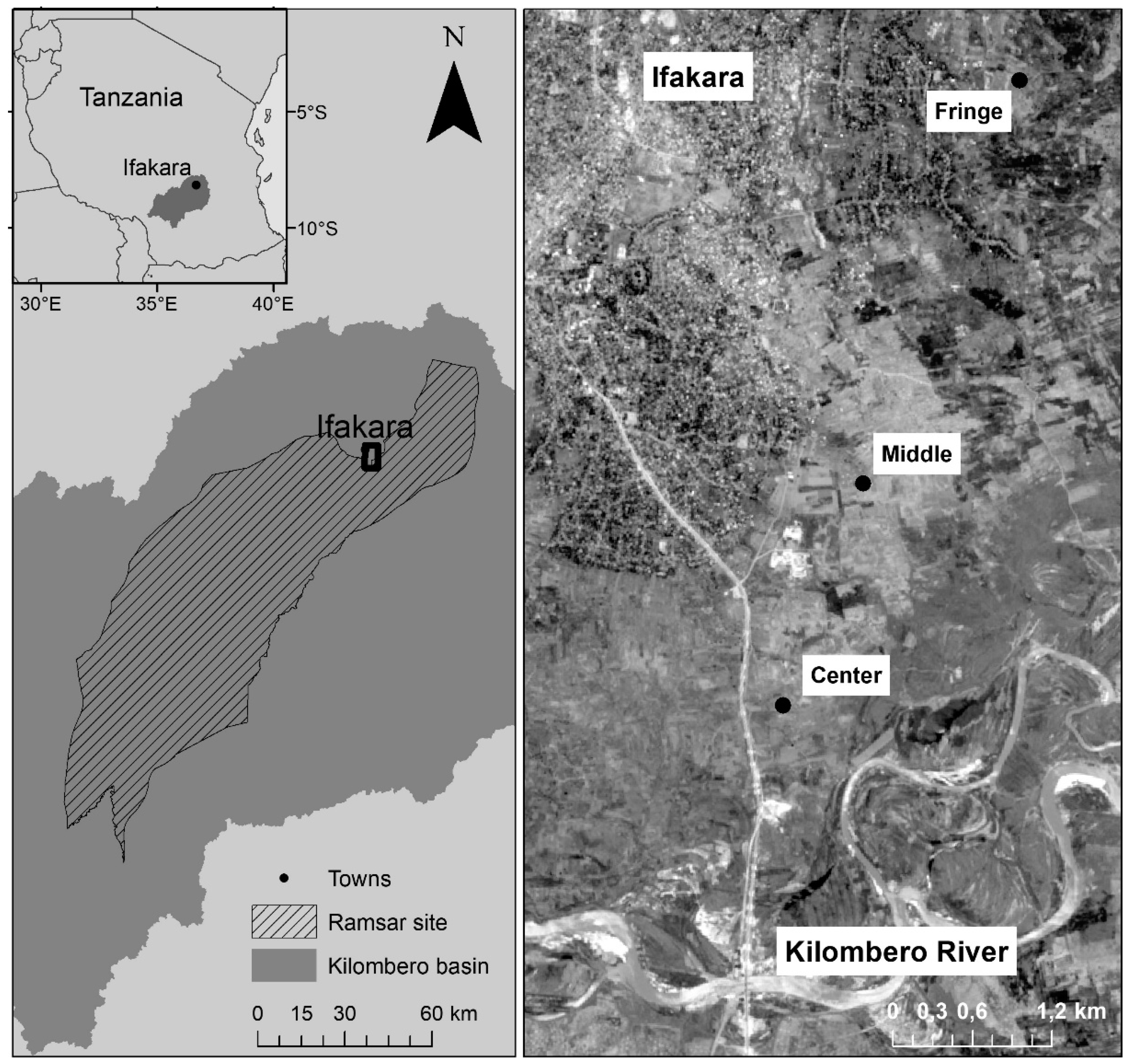
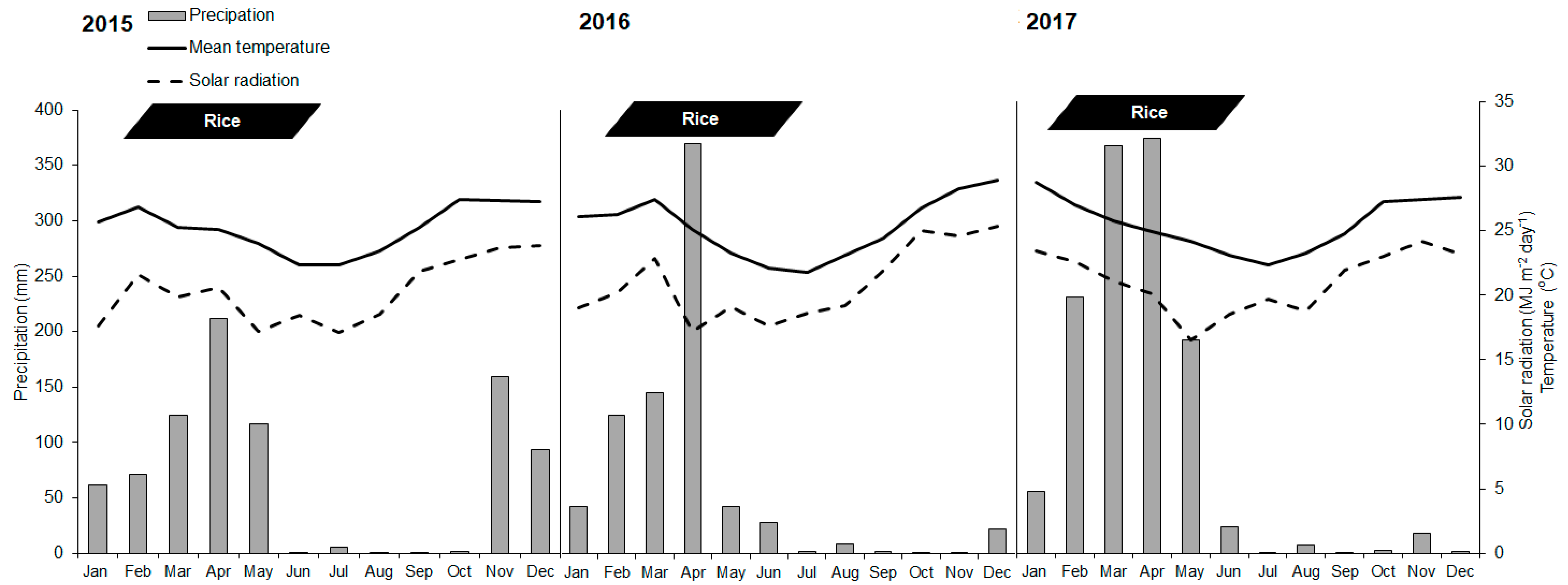
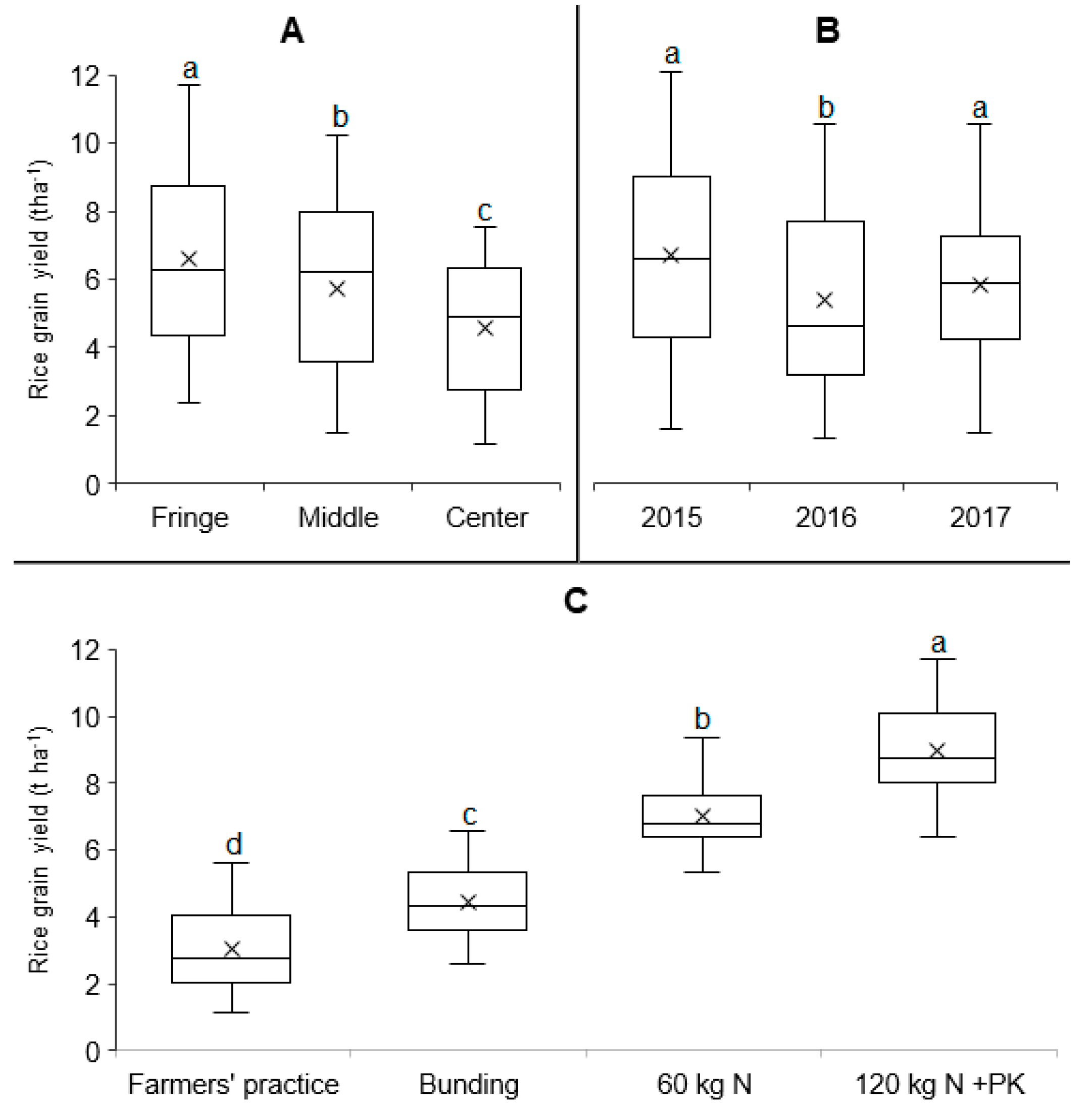
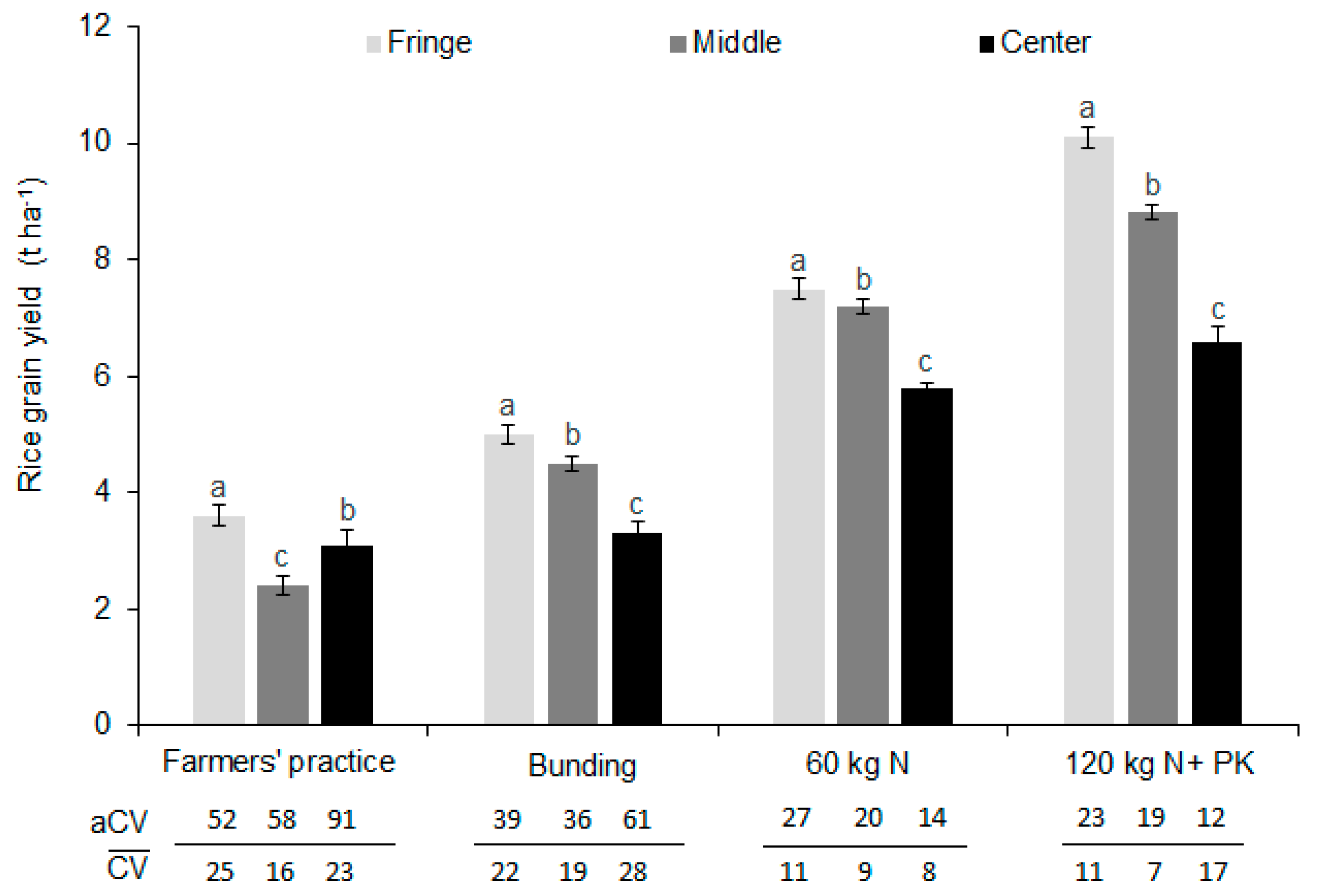

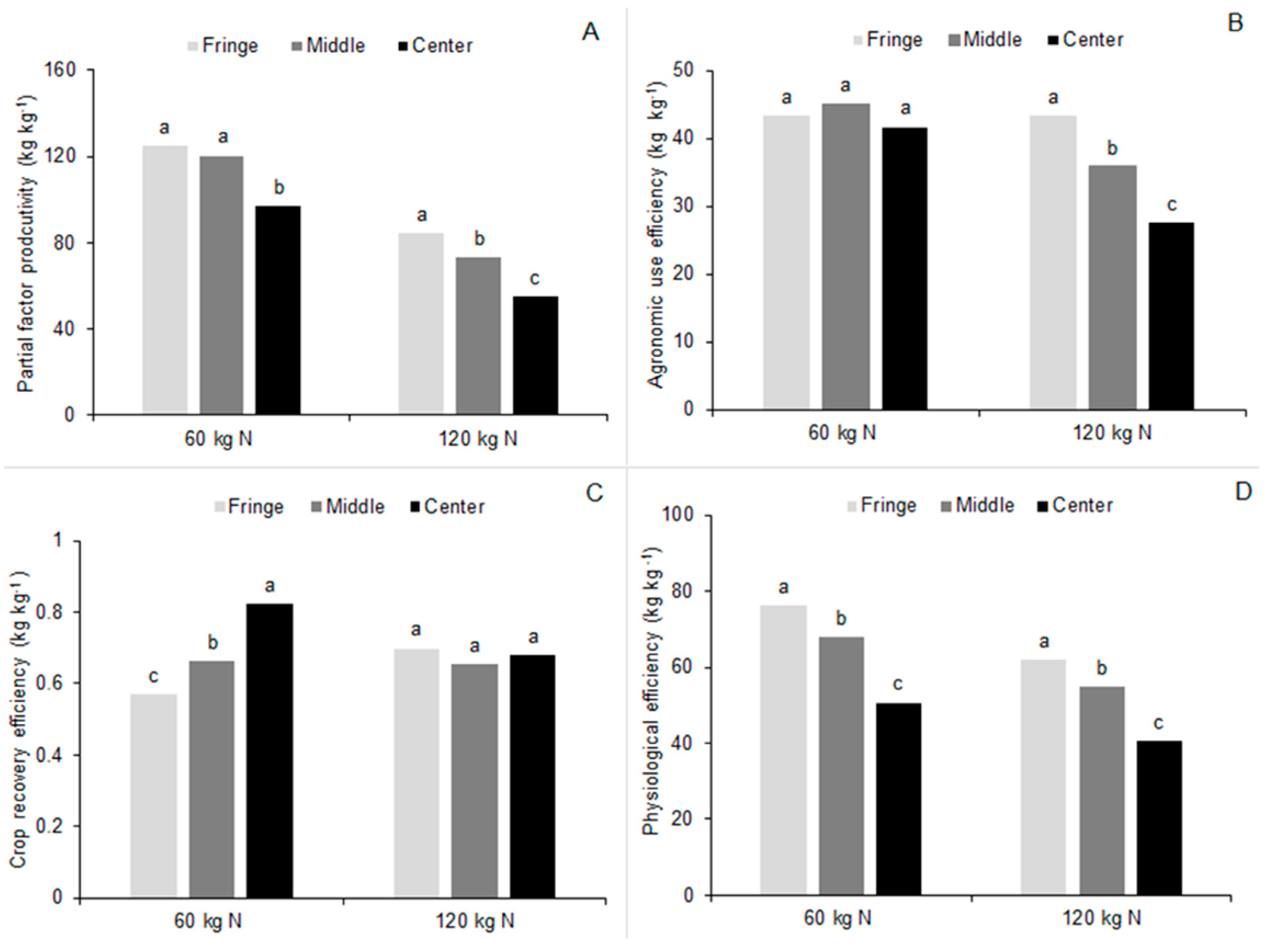
| Characteristic | Fringe | Middle | Center |
|---|---|---|---|
| Distance from river (km) | 6.4 | 4.2 | 1.0 |
| Cumulative evaporation (mm) ‡ | 843 | 713 | 786 |
| Evapotranspiration (mm) ‡ | 1044 | 896 | 969 |
| Ground water discharge (mm) ‡ | 220 | 196 | 109 |
| Change in soil water storage (mm) ‡ | 120 | 233 | 263 |
| Maximum flooding depth (m) | 0.3 | 0.7 | 1.4 |
| Flooding duration (days) | 17 | 22 | 40 |
| Soil texture | silt loam | silt loam | silt clay loam |
| Clay (%) | 14.0 | 20.2 | 35.7 |
| Silt (%) | 58.2 | 60.1 | 52.1 |
| Sand (%) | 27.8 | 19.7 | 12.2 |
| pH (H2O) | 6.0 | 5.8 | 4.9 |
| Total C (g kg−1) | 16.5 | 15.0 | 22.5 |
| Total N (mg kg−1) | 1.0 | 0.9 | 1.7 |
| Available P (mg kg−1) | 47.5 | 16.0 | 9.7 |
| Available K (mg kg−1) | 71.4 | 70.6 | 79.2 |
| Bulk density (g m−3) | 1.41 | 1.31 | 1.26 |
| No. | Treatment | Quantification | Details |
|---|---|---|---|
| 1 | Farmers practice | Yield gap baseline | No bunding, levelling, no mineral N, single weeding |
| 2 | Bunding | Yield gap due to bunding | Bunding, levelling, No mineral N, clean weeding |
| 3 | 60 kg N | Yield gap due to N | Bunding, levelling, 60 kg urea- N ha−1, clean weeding |
| 4 | 120 kg N+ 60 kg PK | Achievable yield in single crop system | Bunding, levelling, 120 kg N + 60 kg P+ 60 kg K + supplementary irrigation |
| Source of Variation | Df | Grain (t ha−1) | Panicles (m−2) | Harvest Index | Filled Grain (%) | 1000 Grain Weight (g) | Biomass (t ha−1) |
|---|---|---|---|---|---|---|---|
| Year | 2 | 18.48 *** | 6.08 ** | 10.87 *** | 92.62 *** | 30.04 *** | 7.86 ** |
| Position | 2 | 44.55 *** | 55.48 *** | 23.64 ** | 1.59 ns | 2.83 ns | 4.14 * |
| Rep (year X Position) | 24 | 3.21 *** | 2.87 *** | 1.57 ns | 1.17 ns | 2.47 ** | 2.41 ** |
| Year X position | 3 | 0.84 ns | 9.16 *** | 6.93 *** | 8.38 *** | 5.81 ** | 2.14 ns |
| Treatment | 3 | 291.78 *** | 71.34 *** | 9.73 *** | 4.19 ** | 23.94 *** | 107.33 *** |
| Year X treatment | 6 | 0.89 ns | 1.29 ns | 1.82 ns | 2.7 * | 6.35 *** | 1.02 ns |
| Position X treat | 6 | 8.06 *** | 0.91 ns | 2.20 ns | 0.25 ns | 0.44 ns | 5.24 *** |
| Year X position X treatment | 9 | 0.39 ns | 1.45 ns | 3.15 ** | 0.24 ns | 3.341 ** | 1.71 ns |
© 2019 by the authors. Licensee MDPI, Basel, Switzerland. This article is an open access article distributed under the terms and conditions of the Creative Commons Attribution (CC BY) license (http://creativecommons.org/licenses/by/4.0/).
Share and Cite
Kwesiga, J.; Grotelüschen, K.; Neuhoff, D.; Senthilkumar, K.; Döring, T.F.; Becker, M. Site and Management Effects on Grain Yield and Yield Variability of Rainfed Lowland Rice in the Kilombero Floodplain of Tanzania. Agronomy 2019, 9, 632. https://doi.org/10.3390/agronomy9100632
Kwesiga J, Grotelüschen K, Neuhoff D, Senthilkumar K, Döring TF, Becker M. Site and Management Effects on Grain Yield and Yield Variability of Rainfed Lowland Rice in the Kilombero Floodplain of Tanzania. Agronomy. 2019; 9(10):632. https://doi.org/10.3390/agronomy9100632
Chicago/Turabian StyleKwesiga, Julius, Kristina Grotelüschen, Daniel Neuhoff, Kalimuthu Senthilkumar, Thomas F. Döring, and Mathias Becker. 2019. "Site and Management Effects on Grain Yield and Yield Variability of Rainfed Lowland Rice in the Kilombero Floodplain of Tanzania" Agronomy 9, no. 10: 632. https://doi.org/10.3390/agronomy9100632





